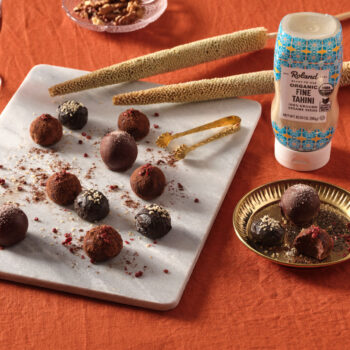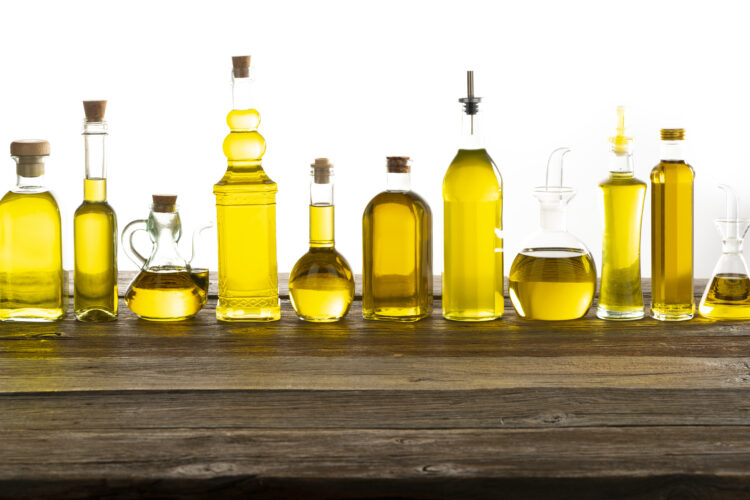December 01, 2021 | Ingredients 101
What is Tahini? Tahini 101

Tahini is a celebrated ingredient in Middle Eastern cuisine that is versatile enough to be used in a variety of dishes from hummus to pita wraps to sweet and savory desserts.
In this Tahini Ingredient 101, we discuss what tahini is, share the back story of the product, and give actionable use cases of the ingredient.
What is Tahini?

Tahini is a thick spread that is made from grinding hulled and lightly roasted sesame seeds. Originating in the Middle East, tahini has become popular in numerous recipes around the world, from hearty falafel sandwiches to modern salads.
Although tahini has a long history, it is trending in the modern day. Check out the Google Trend results for tahini over the past five years.
Restaurants should put tahini on their radar, too. According to Datassential, tahini has been steadily gaining menu penetration, with the strongest being in fast casual restaurant concepts.
Did You Know: Roland Foods' line of tahini are products of Israel, authentically sourced and created using ancient techniques to ensure product taste and quality.
How Does Tahini Taste?
Tahini has a very earthy flavor and is slightly bitter, but not overpowering. Although the spread resembles peanut butter and other nut butters, it does not have a similarly sweet flavor profile. The toasted sesame seed flavor shines through in this creamy, rich ingredient.
Where Does Tahini Come From?
The Science
Sesame seeds the basis of tahini, grow in the pods of a flowering plant which split open and pop when ripe, revealing the seeds within. Sesame seeds that are unhulled still have their outer husk intact, and they typically are not used this way when making tahini. Hulled sesame seeds are lighter in color than their unhulled counterparts and are less bitter in taste. Hulled sesame seeds are an off-white color and are typically what you'll see in the store (or on a bagel!) However, once lightly toasted in preparation to make tahini, the hulled seeds will take on a light brown color.
Grinding the hulled sesame seeds allow a paste to form, which is, you guessed it, tahini. Tahini has a high oil content and therefore should be refrigerated to keep fresh. It also provides a good source of calcium, in fact, tahini boasts nine times as much calcium as peanut butter.
Unhulled roasted sesame seeds can also be made into a paste, but it is darker and more bitter - this paste is often referred to as sesame butter.
The History
Although tahini is popular in the modern day, it has a rich and storied history. In fact, sesame seeds have been cultivated in Egypt since at least 2 AD. In Ali Baba and the Forty Thieves, the phrase "open sesame" magically opens a sealed cave, likely inspired by the ripening of a sesame pod.
During medieval times, tahini was actually a byproduct of sesame oil production. It eventually became a treasured staple in its own right, thankfully!
In many Middle Eastern cultures, the spread is called "tahina" from the Arabic tahn meaning ground. Today, most Western countries use the Greek spelling of tahini. Tahini is a common ingredient in Middle Eastern dishes like hummus and baba ghanoush, but is also used in Chinese, Vietnamese, and Indian cuisines.
How To Use Tahini

Tahini is a very versatile ingredient that can be used in both savory and sweet applications. It is commonly known as a main ingredient in hummus and baba ghanoush, but that is not all it's good for. The spread can be used as a dip on its own and is great for dipping raw vegetables into for a quick snack.
Tahini toast is another application, and the spread can be used to replace nut butters as a topper for your bread.
How about a drizzle? Tahini can be drizzled onto falafel sandwiches, grain bowls, or meats for added flavor. It can also be used as a delicious dressing for salads and cooked or grilled vegetables.
Looking for a sweet application? In the Middle East tahini is used in halva, a confection similar to fudge. You can also add the spread to your cookies or brownies for a deep earthy flavor profile. Tahini ice cream is also a popular dessert that combines the sweetness of cream with the nuttiness of the tahini to create a unique confection.
Roland Foods' Tahini Line
At Roland Foods, we offer an extensive line of authentically-sourced tahini products. From original and fine tahini to our flavored line, you are bound to find a product to fit your culinary needs.
Want to learn more about our offering? Check out our Tahini Product Spotlight here.
Time to Try Tahini
Now that you're well-versed in everything tahini, why not give it a try? You can actually make your own tahini if you're up for the challenge (check out this recipe), but if you're looking for the ready-made product, we've got you covered. Check out our tahini options here.
Roland Foods Recipes with Tahini
Check out our recipes incorporating Roland Foods Tahini Products!
Tahini Dip Trio

Tahini Shortbread Cookies

Tahini Chocolate Truffles

No-Bake Tahini Coconut Swirl Cheesecake

Coconut Cream Mango Parfait with Tahini Caramel

Roland® Tahini Products
Recommended Reads
February 20, 2024 | Food Trends Foodservice Guides
What is an LTO? Leveraging Limited Time Offers in Foodservice
What is an LTO? Limited Time Offers are a valuable tactic used widely across the foodservice landscape to boost sales and drive foot traffic. Learn more about the different types of LTOs, marketing strategies, and how Roland® can be your LTO partner in our comprehensive guide.
December 29, 2023
Cooking Oil Alternatives | Expand Your Pantry with Roland Foods
Navigating the Olive Oil shortage with Roland Foods. Expand your pantry with alternative cooking oils and custom blends.
November 13, 2023 | Food Trends
Roland Foods' 2024 Fine Foods Industry Trends & Predictions Guide
The Roland Foods' 2024 Fine Foods Industry Trends & Predictions Guide gives insights into trending global flavors, ingredients, and dining habits for 2024. Discover our predictions for the biggest food trends this year!










